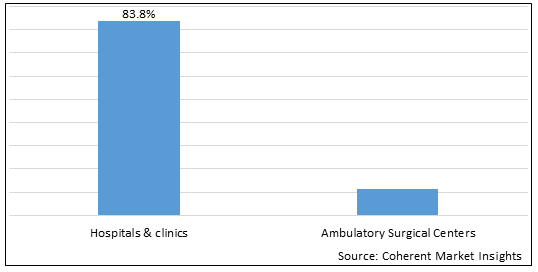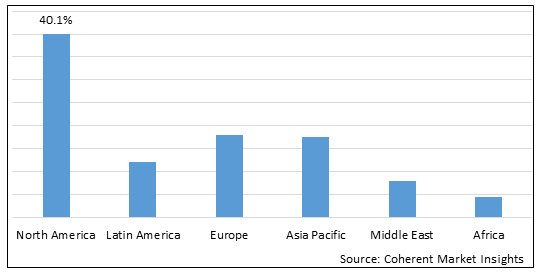There are different types of devices and systems that are used during intraoperative imaging, which include intraoperative X-ray, intraoperative magnetic resonance imaging (MRI), intraoperative computed tomography (CT), intraoperative ultrasound, intraoperative radiation therapy, and others. Amongst these, intraoperative CT is a commonly used intraoperative imaging device during imaging. Computed tomography, also known as a CT scan, is a diagnostic technique used to obtain detailed images of organs, bones, soft tissue, and blood vessels. CT scanner uses computer and X-ray technology to obtain images of internal body organs. CT scanning is a non-invasive, painless, fast, and accurate diagnostic method and is widely used in the diagnosis of various neurological disorders. In the recent past, advancements were made in CT scanner to improve its speed, resolution, and patient comfort.
Global Intraoperative Imaging Market is estimated to be valued at US$ 2,868.7 million in 2022 and is expected to exhibit a CAGR of 6.4% during the forecast period (2022-2030).
Figure 1. Global Intraoperative Imaging Market Share (%), by End User, 2022

To learn more about this report, Download Free Sample
Global Intraoperative Imaging Market - Drivers
Increasing organic strategies such as product launches among market players is expected to propel the Global Intraoperative Imaging Market growth during the forecast period. For instance, in June 2021, FUJIFILM Holdings Corporation, a manufacturer of healthcare solutions and imaging systems, announced the launch of system integration platform designed for endoscopy which will enhance image and data integration endoscopy suites. This scalable solution enables multi-video and image routing and display capabilities that gastroenterologist (GI) physicians need while performing advanced procedures.
Furthermore, key companies focusing on organic strategies such as product approval are expected to propel the growth of the Global Intraoperative Imaging Market during the forecast period. For instance, in March 2021, General Electric, a company which provides medical technology and digital solutions, announced the 510(k) clearance from the U.S. food and drug administration (FDA) for the surgical imaging systems OEC 3D, which is capable of 2D and 3D imaging. OEC 3D will set a standard for intraoperative 3D imaging with precise volumetric images for spine and orthopedic procedures.
Intraoperative Imaging Market Report Coverage
| Report Coverage | Details | ||
|---|---|---|---|
| Base Year: | 2021 | Market Size in 2022: | US$ 2,868.1 Mn |
| Historical Data for: | 2022 to 2030 | Forecast Period: | 2022 to 2030 |
| Forecast Period 2022 to 2030 CAGR: | 6.4% | 2030 Value Projection: | US$ 4,696.2 Mn |
| Geographies covered: |
|
||
| Segments covered: |
|
||
| Companies covered: |
Siemens Healthcare Private Limited, Medtronic, General Electric, IMRIS, SAMSUNG, Ziehm Imaging GmbH, Brainlab AG, Carl Zeiss Meditec AG, Koninklijke Philips N.V., Stryker, FUJIFILM Holdings Corporation, Shenzhen Anke High-tech Co., ESAOTE SPA, Allengers, Analogic Corporation, Shimadzu Corporation, and Activ Surgical |
||
| Growth Drivers: |
|
||
| Restraints & Challenges: |
|
||
Uncover macros and micros vetted on 75+ parameters: Get instant access to report
Figure 2. Global Intraoperative Imaging Market Share (%), by Region, 2022

To learn more about this report, Download Free Sample
Global Intraoperative Imaging Market– Impact of Coronavirus (COVID-19) Pandemic
Since the COVID-19 virus outbreak in December 2019, the disease has spread to over 100 countries across the globe and the World Health Organization declared it a public health emergency on January 30, 2020.
COVID-19 has affected the economy in three main ways: by directly affecting the production and demand for drugs and vaccines, by creating disruptions in distribution channels, and through its financial impact on firms and financial markets. Due to nationwide lockdowns, several countries such as China, India, Saudi Arabia, the UAE, Egypt, and others faced problems with regard to the transportation of drugs and vaccines from one place to another. According to the World Health Organization’s report, manifestation of coronavirus (COVID-19) has resulted in more than 625,248,843 confirmed cases of COVID-19 infected individuals worldwide as of October 25, 2020.
Furthermore, COVID-19 pandemic has a significant impact on the Global Intraoperative Imaging Market, due to a decrease in the number of surgical procedures. For instance in September 2020, there was a substantial effect of COVID-19 on surgical procedures. The surgeon and patient require an intimate relationship, interaction, and contact for performing the procedures. However, due to COVID-19, patients as well as surgeons had the fear to get infected by COVID-19.
Global Intraoperative Imaging Market: Key Developments
In December, 2020, Koninklijke Philips N.V., a multinational conglomerate corporation, partnered with InSightec, one of the global healthcare company to expand access to magnetic resonance-guided ultrasound for incisionless neurosurgery. The expansion is aimed to provide innovative treatment options and the potential to significantly improve the patient and staff experience, enhance health outcomes, and lower the cost of care. Koninklijke Philips N.V., is going to develop compatibility of Philips’ MR Ingenia 3.0T and 1.5T systems with the InSightec Exablate Neuro platform. As a leading innovator in MR imaging, Koninklijke Philips N.V. expanded the role of MR in providing precision guidance for minimally invasive therapy solutions into new treatment areas.
In December 2021, ESAOTE SPA, one of the leading companies in the biomedical equipment sector, announced the beginning of FASTIII, a European randomized clinical trial that will investigate the use of angiography-based vessel fractional flow reserve (CAAS vFFR) by Pie-Medical Imaging in patients undergoing coronary revascularization procedures.
Global Intraoperative Imaging Market: Restraint
The major factors that hinder growth of the Global Intraoperative Imaging Market include the risks of radiation exposure for surgeons as well as patients. For instance, in January 2021 a paper published by the National Center for Biotechnology Information suggested that there is a higher risk of radiation exposures emitted from intraoperative fluoroscopic imaging systems as well as the environment. The surgeons and patients have the risk of increased exposure to ionizing radiation and some side effects include burns, cataracts, carcinogenesis, and hair loss.
Global Intraoperative Imaging Market- Key Players
Major players operating in the Global Intraoperative Imaging Market include Siemens Healthcare Private Limited, Medtronic, General Electric, IMRIS, SAMSUNG, Ziehm Imaging GmbH, Brainlab AG, Carl Zeiss Meditec AG, Koninklijke Philips N.V., Stryker, FUJIFILM Holdings Corporation, Shenzhen Anke High-tech Co., ESAOTE SPA, Allengers, Analogic Corporation, Shimadzu Corporation, and Activ Surgical
Share
Share
Missing comfort of reading report in your local language? Find your preferred language :
Transform your Strategy with Exclusive Trending Reports :
Frequently Asked Questions
Select a License Type
Joining thousands of companies around the world committed to making the Excellent Business Solutions.
View All Our Clients